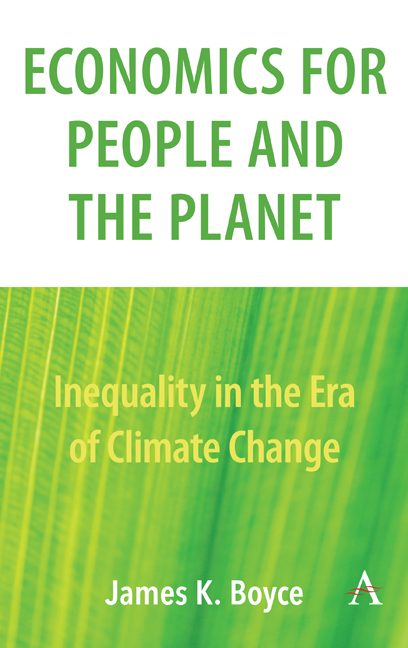Book contents
- Frontmatter
- Contents
- List of Illustrations
- Acknowledgements
- Part I Rethinking Economics and the Environment
- Part II Environmental Injustice
- Chapter 9 Inequality and the Environment
- Chapter 10 Clean Air for All
- Chapter 11 Letter from Flint
- Chapter 12 Let Them Drink Pollution?
- Chapter 13 Letter from Delhi
- Chapter 14 Mapping the Environmental Riskscape
- Chapter 15 Measuring Pollution Inequality
- Chapter 16 Cleaning the Air and Cooling the Planet
- Part III Climate Policy
- Notes
- Publication History
- Index
Chapter 15 - Measuring Pollution Inequality
from Part II - Environmental Injustice
Published online by Cambridge University Press: 12 February 2019
- Frontmatter
- Contents
- List of Illustrations
- Acknowledgements
- Part I Rethinking Economics and the Environment
- Part II Environmental Injustice
- Chapter 9 Inequality and the Environment
- Chapter 10 Clean Air for All
- Chapter 11 Letter from Flint
- Chapter 12 Let Them Drink Pollution?
- Chapter 13 Letter from Delhi
- Chapter 14 Mapping the Environmental Riskscape
- Chapter 15 Measuring Pollution Inequality
- Chapter 16 Cleaning the Air and Cooling the Planet
- Part III Climate Policy
- Notes
- Publication History
- Index
Summary
Air pollution in the United States is distributed even more unequally than income: an interview with Lynn Parramore of AlterNet.
Lynn Parramore (LP): Why did you decide to look at industrial air pollution and inequality? Why is this research important?
James Boyce (JB): What we wanted to do was look at inequalities in the environmental conditions that people experience here in the United States. Industrial air pollution is just one piece of a much broader set of environmental conditions. In addition to air pollution, for example, there's water pollution. And in addition to air pollution from industrial point sources, there's air pollution from mobile sources like cars and diesel trucks. So what we focused on was really one piece of a larger canvas of differences in pollution exposure across the population in this country.
There were two reasons we chose industrial air pollution to illustrate these disparities. One is that for the communities that are impacted by this sort of pollution, it's a very important piece of their total pollution burden. So it's not that it's the most important piece nationwide, but for communities with particularly high pollution burdens, it's a big deal.
The second reason is that the Environmental Protection Agency (EPA) has developed some very high-quality data on air pollution from these facilities. Back in the mid-1980s there was a terrible disaster at a plant owned by a US corporation called Union Carbide in the city of Bhopal in central India. In response to public concern about whether there might be similar risks at industrial facilities here in the United States, Congress passed legislation called the Emergency Planning and Community Right-to-Know-Act. This created something called the Toxics Release Inventory (TRI), which requires any facility in the United States that meets certain criteria to report to the EPA every year its releases of hundreds of toxic chemicals to the air, water and land. So it provides a really detailed database on emissions from industrial facilities.
In the 1990s, the EPA added some additional important pieces to the TRI data. The first is information on the relative toxicities of the chemicals. When inhaled, some of them, for example, pound per pound are 10 million times more toxic than other chemicals. The EPA also looked at how they're distributed in the environment.
- Type
- Chapter
- Information
- Economics for People and the PlanetInequality in the Era of Climate Change, pp. 69 - 74Publisher: Anthem PressPrint publication year: 2019



